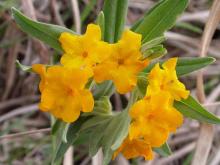Wildflowers, Grasses and Other Nonwoody Plants
Media

Species Types
Scientific Name
Buchloe dactyloides
Description
Buffalo grass is a native perennial warm-season short grass that creeps widely by runners and forms dense mats. As a native, it occurs in the prairies in far northwest Missouri, but it now occurs elsewhere in the state and has become popular as a lawn grass.
Media

Species Types
Scientific Name
Lithospermum canescens
Description
Hoary puccoon's small, tubular flowers arise on spirally condensed stalks that uncoil and elongate as more flowers open toward the tip. Occurs nearly statewide in prairies, glades, pastures, roadsides, and other open areas.
Media

Species Types
Scientific Name
Viola pedata
Description
In springtime, bird's-foot violet can make a glade or bluff top heavenly with its pretty lavender and purple "faces." When you see your first big colony of bird's-foot violets, you will probably never forget it.
Media

Species Types
Scientific Name
Barbarea vulgaris
Description
Yellow rocket is a mustard native to Eurasia that was introduced long ago and today is found across North America. The mustard family used to be called the Cruciferae, because of the cross shape formed by the four petals.
Media

Species Types
Scientific Name
Phlox divaricata
Description
A common, eye-catching native spring wildflower common in woodlands, blue phlox occurs nearly statewide.
Media

Species Types
Scientific Name
Phlox paniculata
Description
Perennial phlox has big, showy clusters of flowers. A tall, late-blooming native wildflower of woodland borders, steamsides, and gravel bars, it is also an old-fashioned garden favorite.
Media

Species Types
Scientific Name
Glandularia canadensis (formerly Verbena canadensis)
Description
One of our jazziest spring flowers, rose verbena catches your eye in the prairies and open areas it prefers. At first glance, you might think this is a type of phlox, but the rough, lobed and toothed foliage will tell you a different story.
Media

Species Types
Scientific Name
Primula meadia (syn. Dodecatheon meadia)
Description
A beloved native spring wildflower, shooting star makes a lasting impression on hikers who encounter a nice big colony of these downward-pointing pink, white, or purplish flowers.
Media

Species Types
Scientific Name
Festuca arundinacea
Description
You’ve seen it a million times, now learn to identify it! Technically an exotic invasive plant, tall fescue is practically everywhere, from lawns to levees, and from pastures to (unfortunately!) prairies.
Media

Species Types
Scientific Name
Iris virginica
Description
Ten species of iris grow wild in our state, but only four of them are native. Of our native irises, this one is the most common. But drainage “improvements” are eliminating the habitat of this beautiful wetland wildflower.
See Also
About Wildflowers, Grasses and Other Nonwoody Plants in Missouri
A very simple way of thinking about the green world is to divide the vascular plants into two groups: woody and nonwoody (or herbaceous). But this is an artificial division; many plant families include some species that are woody and some that are not. The diversity of nonwoody vascular plants is staggering! Think of all the ferns, grasses, sedges, lilies, peas, sunflowers, nightshades, milkweeds, mustards, mints, and mallows — weeds and wildflowers — and many more!





















